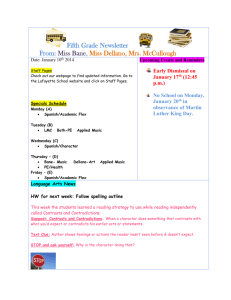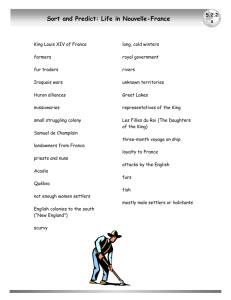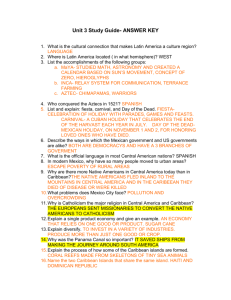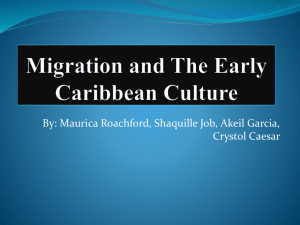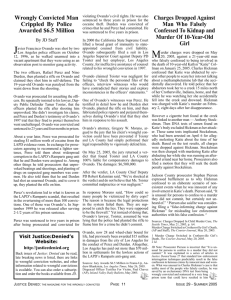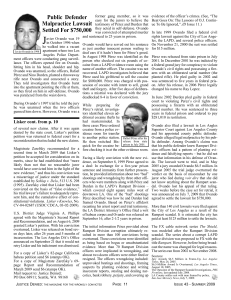File
advertisement
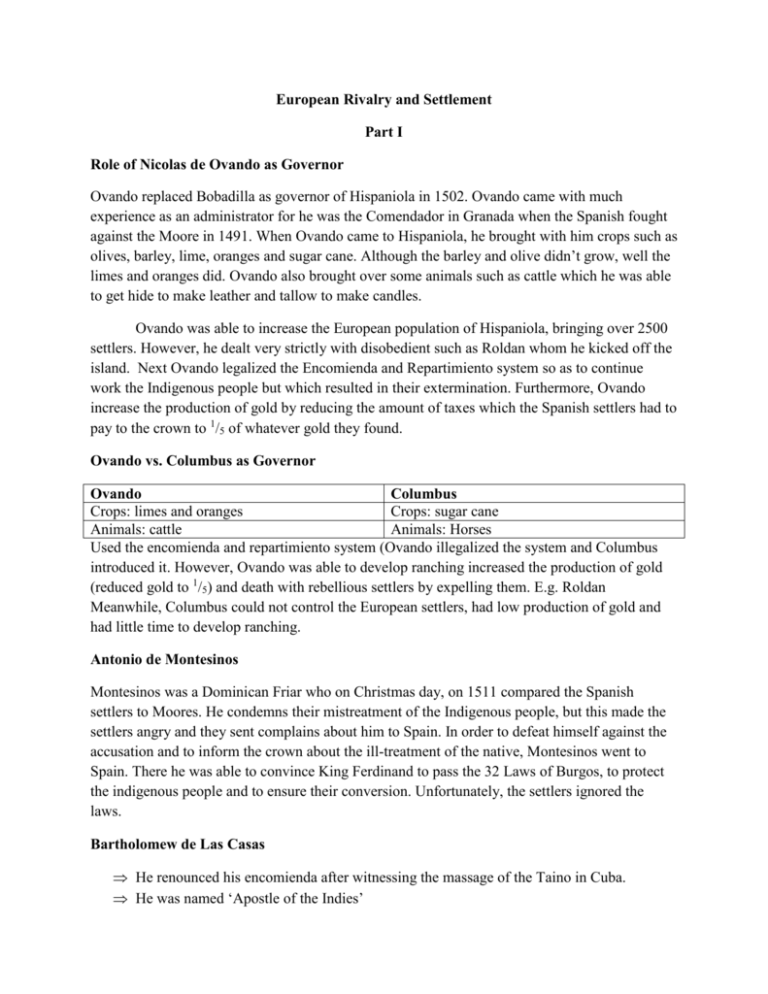
European Rivalry and Settlement Part I Role of Nicolas de Ovando as Governor Ovando replaced Bobadilla as governor of Hispaniola in 1502. Ovando came with much experience as an administrator for he was the Comendador in Granada when the Spanish fought against the Moore in 1491. When Ovando came to Hispaniola, he brought with him crops such as olives, barley, lime, oranges and sugar cane. Although the barley and olive didn’t grow, well the limes and oranges did. Ovando also brought over some animals such as cattle which he was able to get hide to make leather and tallow to make candles. Ovando was able to increase the European population of Hispaniola, bringing over 2500 settlers. However, he dealt very strictly with disobedient such as Roldan whom he kicked off the island. Next Ovando legalized the Encomienda and Repartimiento system so as to continue work the Indigenous people but which resulted in their extermination. Furthermore, Ovando increase the production of gold by reducing the amount of taxes which the Spanish settlers had to pay to the crown to 1/5 of whatever gold they found. Ovando vs. Columbus as Governor Ovando Columbus Crops: limes and oranges Crops: sugar cane Animals: cattle Animals: Horses Used the encomienda and repartimiento system (Ovando illegalized the system and Columbus introduced it. However, Ovando was able to develop ranching increased the production of gold (reduced gold to 1/5) and death with rebellious settlers by expelling them. E.g. Roldan Meanwhile, Columbus could not control the European settlers, had low production of gold and had little time to develop ranching. Antonio de Montesinos Montesinos was a Dominican Friar who on Christmas day, on 1511 compared the Spanish settlers to Moores. He condemns their mistreatment of the Indigenous people, but this made the settlers angry and they sent complains about him to Spain. In order to defeat himself against the accusation and to inform the crown about the ill-treatment of the native, Montesinos went to Spain. There he was able to convince King Ferdinand to pass the 32 Laws of Burgos, to protect the indigenous people and to ensure their conversion. Unfortunately, the settlers ignored the laws. Bartholomew de Las Casas He renounced his encomienda after witnessing the massage of the Taino in Cuba. He was named ‘Apostle of the Indies’ He became Bishop of Chiapas – converted some Mayas. In Guatemala, he translated the Bible into Maya songs. He passed the new Laws to protect the Indigenous people. He wrote books on the ill-treatment of Indigenous People. Books such as: (i) ‘A Brief History on the Destruction of the Indies’, (ii) ‘De Único Modo’ Conquest of Cuba In 1511, Diego Columbus ordered Diego Velázquez to conquer Cuba. The Spaniards under Velasquez, brutally massacred thousands of Tainos who were caught off guard while celebrating a feast. The first capital established by the Spaniards was ‘Santiago de Cuba’. His was used as the main trading center in the Caribbean. Cuba also became a prosperous island by producing tallow and hide; it also had more gold than Hispaniola, Puerto Rico and Jamaica. Conquest of Puerto Rico Nicolas de Ovando ordered Juan Ponce de León to conquer Puerto Rico in 1508. Ponce de Leon set up the first settlement Cappara but later established San Juan as the capital. The Borinqueños (war-like Taino group) and the Kalinagos who lived on the island, fiercely resisted the Spanish conquest and Ponce de León had to get reinforcements from Hispaniola to put down the indigenous people. Conquest of Jamaica Diego Columbus ordered Juan de Esquivel to conquer Jamaica in 1510. Esquivel set up his first settlement of Seville in St. Ann’s Bay. Later the Villa la Vega (Spanish Town) replaced St. Ann’s Bay as the capital. The island provided little wealth as no gold was found there. The Tainos who lived on the island gave little resistance and many died from diseases, ill-treatment and suicide. Spanish Colonial Government King – absolute monarch Residencia – check on the governor conducted by three judges Visitador – an official judge who made a surprise visit to the Americas to check the work of governor/viceroy. Audiencias – travelling between court consisting of 3-15 members who were called ordones; they were lawyers heard legal cases and check governor. Viceroy – governors who were given administrative of 1 or more area. Corregidor – came to check work of Cabildo. Cabildo – municipal government of town members were called regidores Alcaldes – Mayors of towns The Spaniards used their councilor system of government to administrate over their emperor in the New World. at the top of the empire was the King who was an absolute monarchy. Below him was the Council of Castle the Council of Finance and the Council of Indies. The Council of Indies dealt directly with affairs regarding the Americas especially those of the legal nature. The Council of Indies then appointed three officials to check on the Viceroy and governor or administrated. In the Americas first there was the conducting of a Residencia, made by three judges on the performance of an outgoing governor. Another system of check was the Visitador, who was an official whom made surprised visits to the Americas so as to check on the performance on any current Viceroys or governor in office. The third system of checking on the government was conducted by the Audiencia, in which this was a travelling law count consisting of between 3-15 members who were called orderos. They were lawyers who heard legal cases, advice and check the current governor. Next were the Viceroys or governors, who were responsible for administrating over one or more territories. For example, some ruled over 1 territory such as Hispaniola while others were given greater powers so ruling over Mexico, Central America, the West Indies, Colombia and Venezuela. Below the Viceroys was the local government called the Cabildo. They administrated over towns and members were called regidores. Among the regidores an Alcalde or mayor was selected, however, either the Cabildo or mayor were checked by another official known as the Corregidor. Trade Winds For almost 300 days of the trade winds blow into the Caribbean. They are caused by the high pressure on the equator sucking in cold air from the arctic. As the Earth rotates from East-West, the air currents are turned towards the west, where the Earth has its greatest circumference. The equator’s strength is constant and never more than 14 knots so they do not endanger sailing ships. In entering the Caribbean, it was more ideal for ships to enter via Dominica and Martinique or Tobago and Granada or Trinidad and Tobago when leaving the Caribbean. Ships usually exited via the Yucatán channels. Ocean Currents There are two current systems which merge about the Lesser Antilles. These are the South Equatorial Currents and North Equatorial Currents. These currents move at between 5 – 8 knots and maintain this speed as they circle the Caribbean in a clockwise direction. They made East to West navigation in the Caribbean relatively easy, but West to East navigation almost impossible. Early Production of Gold Columbus and the early settlers wanted gold in great quantities, but gold could not be found in great amount in Jamaica, Hispaniola and Puerto Rico. Although gold production in Hispaniola did rise to 500,000 ducats, the Spaniards soon exhausted all the gold in that was found. It was not until the conquest of the Aztec in Mexico in 1519 and the Incas in South America in 1539 that the Spaniards began producing tremendous amount of gold, i.e...In 1587 the Spaniards were able to send 30 million ducats from the Americas to Spain in order to transport such large amount of gold. The Spaniards melted down the gold in bars called bullions. Early Production of Sugar Obstacles faced – sugar cane was first brought into the Caribbean by Columbus in 1493. However, the credit to the production of sugar goes to Gonzalo Velosa who created the first mill called the trapiche in 1515. Sugar came in demand as a sweetener for exotic drinks such as coffee and tea. It was also used in the Confectionery Industry (jams, jelly, cakes, etc.) The sugar industry faced three main problems: capital, labor, and technology. The problem of capital came with the fact that an owner of a sugar estate needed at least 12,000 ducats in order to finance the buying of a large estate, equipment such as: coppers and carts and machinery such as a mill. The Spanish settlers who wished to own an estate were aided financially. The Spanish colonial government who took a portion of the profits made on the sale of sugar so as to get back the money they had loaned. Another problem faced in producing sugar was the technology or expertise in how to make sugar. The settlers themselves were ignorant about how to produce sugar; therefore, the government got some expert from the Canary island and some Jews to come to the Caribbean to assist the settlers in the production. The first machinery used to crush cane was the trapiche which is either animal or manual power. Finally, the settlers needed sufficient laborers to produce sugar. The indigenous people by 1500 were significantly reduced in numbers due to high deaths under the encomienda system. Therefore, in 1815, the Spanish government through an asiento (special license) began obtaining African slaves to work on their sugar estates. They therefore became the regular labor force. Mercantilism System This was the system whereby Spain control trade in her empire by allowing only Spanish ships to take goods to the Spanish colonists in the New World and that the goods from the colonist be traded only with Spain and only in Spanish ships. Convoy System In order to protect her trade in the Americas, Spain developed a convoy system. This was whereby a Floata or Cargo ship would leave Spain around May and would region in the Caribbean by Armada or battle ships which surrounded the Floata so as to protect it from any potential attacks. Casa de Contracción The house of trade was set up in order to control trade in the Spanish Colonies. This group consisted of a treasurer who registered all the gold and silver brought from the colonist, a controller who kept accounts of crew and settlers who went to the Spanish colonies and there were business managers who kept accounts of expenses and profits made in the colonies. Functions – the house of trade was responsible for: a) Control of all goods gotten from the Spanish colonies. b) Registration of all ships which left Spain for the American colonies. c) Registrations of all emigrants who left Spain to live in the colonies. d) Acting as a Maritain court to deal with offenses such as illegal trading and the failure of those who could not pay the required tax to the crown. e) Acting as an Advisory Council on matter regarding politics and finances in the colonies. f) Collector of duties on trade of 21/2 % to 7%.

